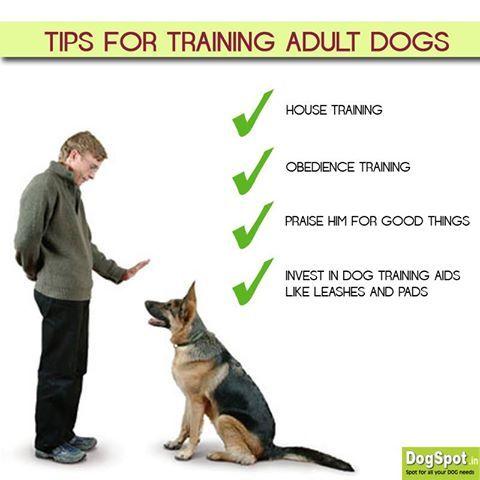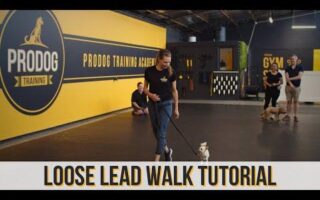Unlocking Potential: The Journey of Adult Dog Training
In the vibrant tapestry of canine companionship, the bond between humans and their dogs weaves a narrative rich with love, loyalty, and learning. While much is often said about the exuberant joys of training a puppy—those unforgettable moments of first commands and playful mischief—there exists another chapter that warrants equal attention: adult dog training. Whether you’ve welcomed a rescue into your home, adopted an older dog from a shelter, or simply wish to refine the behaviors of your long-time furry friend, training an adult dog can be an immensely rewarding experience. Far from a mere task, this process opens a door to communication and understanding, nurturing a partnership that enhances both your lives. In this article, we will embark on a journey exploring the principles, techniques, and countless benefits of adult dog training, revealing how it can transform your relationship with a beloved companion, regardless of age or background. Join us as we delve into the world of training—where patience meets practice, and every wag of the tail tells a story of progress.
Table of Contents
- Understanding Canine Behavior for Effective Training
- Essential Techniques for Reinforcing Positive Habits
- Creating a Structured Training Environment
- Addressing Common Challenges in Adult Dog Training
- Q&A
- In Conclusion
Understanding Canine Behavior for Effective Training
To effectively train an adult dog, it’s crucial to first grasp the fundamental aspects of canine behavior. Unlike puppies, adult dogs come with their own set of experiences and habits, which can significantly influence their response to training. One of the vital considerations is understanding their body language, which includes:
- Tail position: A high, wagging tail often indicates excitement, while a tucked tail may signal fear or submission.
- Ear orientation: Forward-facing ears can show curiosity or attentiveness, while flattened ears typically express anxiety.
- Posture: A relaxed stance indicates comfort, whereas a stiff or tense posture may suggest stress or aggression.
Additionally, recognizing the impact of various environmental factors on your dog’s behavior can lead to more effective training techniques. For instance, distractions in the surroundings can hinder focus, making it challenging for adult dogs to learn new commands. Some effective methods to enhance training sessions might include:
| Training Tip | Description |
|---|---|
| Short Sessions | Limit sessions to 5-10 minutes to maintain their attention and reduce fatigue. |
| Consistent Cues | Use the same words and signals for commands to avoid confusion. |
| Positive Reinforcement | Reward good behavior promptly with treats, praise, or playtime. |
Essential Techniques for Reinforcing Positive Habits
One of the most effective methodologies in adult dog training emphasizes the significance of positive reinforcement. This approach not only enhances your dog’s learning experience but fosters a stronger bond between you and your furry companion. Here are some techniques to implement positive reinforcement effectively:
- Consistency is Key: Ensure commands and cues are consistent across all family members.
- Timing Matters: Reward your dog immediately after they exhibit the desired behavior to create a clear association.
- Use High-Value Treats: Select treats that your dog finds particularly irresistible to keep them motivated.
- Celebrate Small Wins: Acknowledge even minor successes during training sessions to build confidence.
In addition, utilizing visual aids, such as charts or tables, can significantly aid in tracking your dog’s progress and maintaining motivation. By incorporating a reward schedule, you can create a structured yet flexible training system. Here’s a simple example:
| Day | Command | Reward |
|---|---|---|
| Monday | Sit | Cheese Cubes |
| Wednesday | Stay | Pumpkin Treats |
| Friday | Come | Chicken Snacks |
Creating a Structured Training Environment
Establishing a structured training environment is essential for adult dogs, as it helps them understand expectations and fosters a sense of security. Begin by designating a specific area for training sessions, ensuring it is free from distractions. This can be a quiet room in your home or a secluded section of your yard. Having a consistent location helps your dog associate that space with learning. Another vital element is to create a routine. Dogs thrive on predictability, so schedule regular training times to reinforce good behavior and maintain consistency.
To further enhance the training experience, utilize positive reinforcement techniques that reward desired actions. This can include:
- Treats: Offer small, tasty snacks for completing tasks.
- Praise: Use verbal affirmations and petting to reinforce good behavior.
- Play: Incorporate playtime as a reward after a successful training session.
Additionally, consider the following elements that can create an enriching training atmosphere:
| Training Element | Description |
|---|---|
| Consistent Commands | Use the same words for actions to avoid confusion. |
| Short Sessions | Keep training sessions brief (5-10 minutes) to maintain focus. |
| Patience | Stay calm and patient; learning takes time. |
Addressing Common Challenges in Adult Dog Training
Training an adult dog can present unique challenges that may require a bit more patience and creativity compared to training a puppy. Many adult dogs come with established behaviors and habits, making it essential to first understand their background and previous experiences. For instance, a dog that was never socialized may struggle with meeting new people or other pets. To effectively manage these situations, consider utilizing counter-conditioning techniques by rewarding the dog for calm behavior in the presence of triggers. Consistency is critical; maintaining regular training sessions will help reinforce positive behaviors.
Another hurdle in adult dog training is overcoming the fear or anxiety that some dogs may exhibit. It’s vital to create a safe training environment where the dog can feel comfortable and secure. Incorporating gradual exposure to new experiences can help build their confidence. Strategies such as desensitization, where you slowly introduce the dog to the feared object or situation, can be beneficial. Additionally, using positive reinforcement such as treats, praise, or playtime can accelerate learning, encouraging the dog to associate the previously scary situation with something enjoyable:
| Challenge | Solution |
| Established Habits | Focus on counter-conditioning and consistency. |
| Fear and Anxiety | Create a safe space and use gradual exposure. |
| Lack of Motivation | Utilize positive reinforcement techniques. |
Q&A
Q&A: Unlocking the Secrets of Adult Dog Training
Q1: Why is adult dog training important?
A1: Adult dog training is crucial for several reasons. First and foremost, it enhances the bond between you and your dog, promoting communication and understanding. Additionally, trained adult dogs exhibit better behavior, which leads to a more harmonious household. Training can also address any lingering behavioral issues, ensuring that your furry friend is a well-mannered companion in various situations.
Q2: Is it ever too late to train an adult dog?
A2: It’s never too late! While training a puppy may be easier due to their impressionable nature, adult dogs possess the ability to learn, adapt, and change. With consistency, patience, and positive reinforcement, you can teach an adult dog new tricks, commands, and behaviors—even the rescue dog who has seen the world can learn new skills!
Q3: What are the best training methods for adult dogs?
A3: Positive reinforcement is often the most effective method. This involves rewarding desired behaviors with treats, praise, or playtime, making the learning experience enjoyable for your dog. Techniques like clicker training can also be quite effective. Remember, patience is key; every dog learns at their own pace.
Q4: How long should training sessions last for adult dogs?
A4: Training sessions for adult dogs typically should be kept short and engaging—around 5 to 15 minutes is ideal. Frequent, short sessions tend to keep your dog’s attention and prevent them from becoming overwhelmed or bored. You can always mix in training with walks or playtime to keep it fun!
Q5: What common behavioral issues can be addressed through training?
A5: Many common issues can be improved with training, including jumping on people, leash pulling, excessive barking, and separation anxiety. Establishing commands for “sit,” “stay,” and “come” can prevent unwanted behaviors and establish safety. Training is also the first step toward correcting these issues.
Q6: How can I keep my adult dog motivated during training?
A6: Motivation can vary from dog to dog, so it’s important to find what excites your pup. Some dogs respond best to tasty treats, while others thrive on praise and affection. Moreover, incorporating toys or games can make training feel more like playtime rather than a chore—keeping the atmosphere lively and encouraging!
Q7: Can professional training classes help, or is self-training effective?
A7: Both options have their merits! Professional training classes offer structured environments and expert guidance, which can benefit both dog and owner. However, self-training can also be successful if you feel confident in your abilities and have the time to commit. Sometimes, a mix of both can yield the best results!
Q8: How can I measure my dog’s progress in training?
A8: Progress can be gauged through consistency, increased responsiveness, and the ability of your dog to perform commands in varying environments. Keep track of milestones, whether it’s mastering a new command or showing improved behavior during walks. Celebrate the small victories—training is as much about the journey as the destination!
Q9: What should I do if my adult dog shows resistance to training?
A9: Resistance is normal and can arise for various reasons, from distractions to fear or anxiety. It’s essential to remain patient and assess the situation. Try adjusting your approach—simplifying commands, using higher-value rewards, or creating a calmer training environment may help. If challenges persist, consulting a professional trainer might provide new strategies tailored to your dog’s needs.
Q10: How can I maintain the skills learned during training?
A10: Consistency is vital! Incorporate training into your daily routine through casual reinforcement during walks, playtime, or mealtime. Regular practice ensures that commands remain fresh in your dog’s mind. Additionally, consider joining a dog club or group where you can practice socialization skills with other dogs and handlers, keeping both you and your pup engaged!
With these insights, you’re well-equipped to embark on the rewarding journey of adult dog training! Embrace the experience—both you and your dog will come out stronger and more connected. Happy training!
In Conclusion
As we conclude our exploration into the world of adult dog training, it’s essential to remember that every dog is a unique canvas, waiting for the brushstrokes of patience, understanding, and consistency. The journey of training an adult dog may come with its own set of challenges, but it is also filled with the rewarding moments of connection and growth. By embracing positive reinforcement and fostering an environment of trust, you can transform not just your dog’s behavior but your relationship as well. Each session, each command learned, becomes a building block in a strong partnership, paving the way for a happier, well-adjusted companion.
So, as you embark on this adventure, remember that it’s not just about teaching commands or perfecting tricks; it’s about nurturing a bond that will bring joy to both you and your furry friend. With dedication and a little creativity, the possibilities are endless. Happy training!



